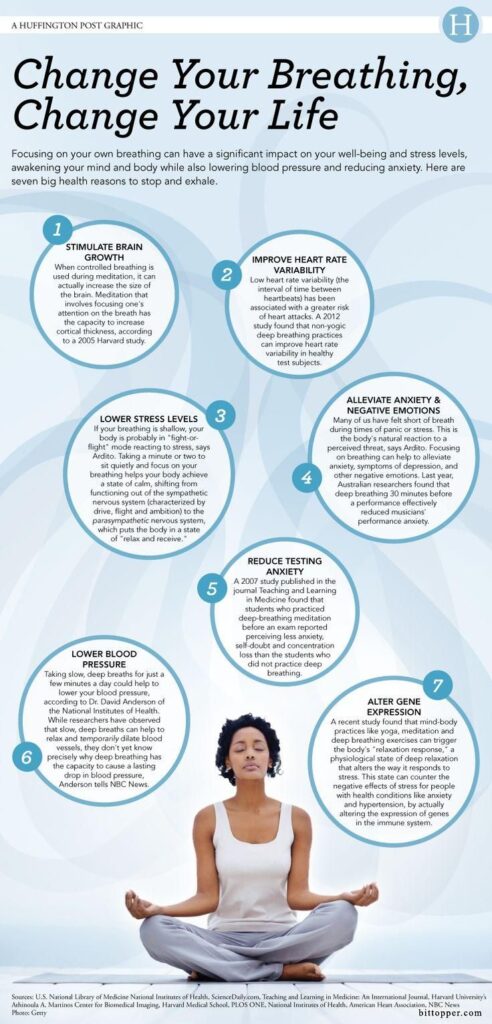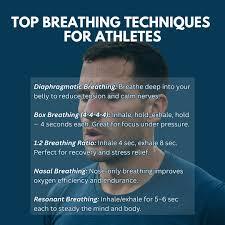The Moment Before Everything
The crowd fades into a hush. A sprinter crouches in the starting blocks, eyes fixed ahead. A tennis player steadies her hand before a crucial serve. A basketball player takes a single, slow breath before releasing the winning free throw. In these fleeting seconds-before movement, before impact, before sound-champions are made.
These are not mere pauses in the action. They are powerful transitions between preparation and performance. In that stillness, the mind speaks louder than the body and the message it sends shapes the outcome before the race even begins. It’s not just raw skill or physical conditioning, that gives elite performers the edge in these crucial moments. It’s a mental mastery and at the heart of that mastery lies something deceptively simple: breath.
Breath is more than survival. It’s a strategy grounded in science. It is the invisible tool that separates pressure from panic, chaos from control. The way an athlete breathes in the final seconds before a race isn’t an accident—it’s a trained response, a ritual that activates presence and launches them into flow.
The Science and Psychology of Breath
Breath is more than air. It’s the steering wheel of your nervous system. The way you breathe signals your brain how to respond: fight, freeze, or focus. Shallow, rapid breaths tell your body there’s danger. Deep, slow breaths say, “You’re safe.” This distinction can change everything under pressure.
When you take control of your breath, you take control of your brain chemistry. Deep breathing activates the parasympathetic nervous system, the body’s natural calming mechanism. It lowers heart rate, reduces cortisol levels, and redirects energy from survival to performance. You go from tense to tuned in.
This calm is crucial when striving to enter the flow state -a mental zone where skill and challenge meet in perfect balance. In flow, distractions fade. Time slows. Athletes and performers describe it as effortless. Getting there, however, isn’t luck. It requires mental quiet and laser focus, both of which start with the breath.
Breath also links directly to focus and body awareness. When you’re stressed, you lose touch with your body. Your hands shake, legs tighten, and vision narrows. Breathing reestablishes that mind-body connection. It grounds you. It makes your technique accessible when your emotions want to hijack the moment.
Most people overlook this hidden skill. They train harder, practice longer, but neglect the very tool that unlocks their potential. Breath is the switch that moves you from reactive to responsive, from frantic to fluid.

Champions understand this, and they use it to their advantage, before the whistle blows, before the spotlight shines, before the pressure hits.
Adrenaline: Fuel or Saboteur?
Adrenaline is the body’s built-in supercharger. Released in moments of stress or excitement, it sharpens focus, increases strength, and readies muscles for quick action. This powerful hormone is part of the fight-or-flight response triggered by the sympathetic nervous system. In short bursts, adrenaline can give athletes the edge they need to perform at their peak.
However, without control, this same boost can backfire. Too much adrenaline can lead to tunnel vision, shaky hands, and mental fog. It pushes the body into overdrive, sometimes causing the brain to freeze rather than flow. In elite performance, that thin line between focus and frenzy can mean the difference between a win and a breakdown.
Breath is the lever that controls the intensity of the adrenaline surge. Slower, deeper breathing tells the body it’s safe, signaling the parasympathetic nervous system to counteract the effects of stress. This shift helps lower heart rate and reduce cortisol levels, allowing the mind to stay alert but calm. Harvard Health explains how breath can directly influence stress physiology.
Athletes who master this can “surf” the wave of adrenaline, using its energy without letting it knock them down. It’s not about eliminating nerves, it’s about regulating the response. Breath becomes the steering wheel in moments when emotions run high and the stakes are elevated.
Whether it’s before a 100-meter sprint or a final round of spelling bee, controlling your breath means controlling your chemistry. And that, more than talent or strength, is what gives you the advantage when pressure peaks.
The Champion’s Breath Routine
Before the competition begins, many champions turn inward. Not to think, but to breathe. Their goal isn’t just physical readiness, but mental stillness. And they achieve it using a simple but powerful tool: a pre-performance breath cycle.
Here’s how it works:
Inhale deeply for 3 seconds.
Exhale slowly for 6 seconds.
Repeat 5 times.
This cycle activates the parasympathetic nervous system -the body’s “rest and digest” mode-which counters stress and induces calm. A longer exhale signals safety to the brain, reducing heart rate and lowering cortisol levels. It’s a natural way to quiet nerves before the spotlight hits.
Top performers across disciplines use this technique. From Olympic sprinters to concert pianists, mastering breath isn’t just about reducing anxiety, it’s about entering the zone. It gives you space to focus, control over adrenaline, and the mental clarity to perform instinctively.
This isn’t meditation. It’s performance priming. In less than a minute, you can shift from reactive to responsive. You’re not trying to eliminate adrenaline. You’re aiming to regulate it, so it fuels rather than floods.

Try making this breath cycle a habit. Use it before exams, presentations, or tryouts. In high-stakes moments, it’s your invisible edge with no equipment required.
Training the Inner Game: Beyond Skills
Success in any performance isn’t just about talent or physical preparation. It’s about how well you manage your mind in high-pressure moments. The athletes we call champions are not just strong, they’re emotionally disciplined. They know how to keep their composure when everything is on the line.
Most people spend hours training their bodies but overlook the mental side entirely. Champions do the opposite. They train their state of mind just as deliberately as they train their technique. They prepare for nerves, doubt, mistakes, and unpredictability. This mental readiness is what keeps them steady while others crumble.
Breath is the bridge between emotion and performance. When frustration builds or fear creeps in, a controlled breath pattern resets the nervous system. Breath helps you respond instead of react. It sends the message: “I’m safe. I’m here. I’m ready.”
This isn’t about pretending to be calm. It’s about practicing calm until it becomes your default. Breath helps you pause and reset. It becomes your mental muscle memory. Your very own reset button. Your personal power switch. No matter what happens, you return to it and in doing so, return to yourself.
By training your breath, you’re not just preparing for one race or one performance. You’re building an inner foundation that shows up in every high-stakes moment of your life. Champions understand that confidence isn’t just what you feel. It’s what you build through practice. And it starts with how you breathe.
Performance Is Everywhere
The pressure to perform doesn’t just exist on the field or court. It shows up in classrooms, on stages, and across boardroom tables. Anywhere there’s an audience or expectation, there’s performance and pressure.
Debaters often freeze mid-argument, not from lack of knowledge, but from nerves. Drama students forget lines they’ve rehearsed for weeks. Interviewees stumble over simple questions. In all these moments, it’s not skill that fails. It’s the mindset.
Breath becomes the secret tool to reclaim control. Just a few slow, deliberate cycles can shift you from anxious to alert, from fearful to focused. It gives your brain the signal: “We’re safe. Let’s go.”
Whether you’re about to deliver a speech, pitch an idea, or walk on stage, the principles remain the same. Champions breathe before they act. That calm, prepared mindset isn’t just for athletes, it’s for anyone who wants to show up as their best self when it counts most.
Case Study: Maya’s Story
Maya was a high school student known for her talents both on the track and on stage. She was a star sprinter and also played lead roles in her school’s musical productions. But before every performance-whether athletic or artistic-she struggled with anxiety. Her mind would race, her body would tense, and her confidence would slip away.
At first, she thought this nervousness was just part of the process. “Maybe I’m not cut out for big moments,” she told herself. Coaches and teachers noticed her dip in performance just before major events. It wasn’t her ability that failed her. It was the mental weight she carried to the starting line or the stage.
Everything began to shift when her track coach taught her a simple breathing routine: inhale for 3 seconds, exhale for 6, repeat 5 times. Maya was skeptical at first. Could something so small really change how she felt? But she gave it a try before her next meet. For the first time, she felt grounded instead of overwhelmed.
The change was subtle but powerful. Her heartbeat slowed. Her thoughts settled. Her stride was smoother. Breath helps you calm the storm inside, and Maya realized that mastering this technique gave her back control—something anxiety had taken away.
Soon, she used the same breath cycle before auditions and even a big college interview. The fear never fully disappeared, but she had a tool to meet it with strength. Breath helps you show up as your best self. Even when the pressure is highest.
Mindset Strength Training
Champions are not made by skill alone. They are forged in the pressure they learn to handle. Just like muscles grow through resistance, the mind strengthens through stress, if it’s trained well. That’s where the concept of Mindset Strength Training comes in.
This training is about building mental resilience deliberately. It doesn’t happen by accident. It happens by routine. And the first exercise in that routine isn’t visualizing success or setting goals. It’s breathing. Breath helps you slow down your thoughts so you can choose your response, not just react to stress.
Think of it like push ups for the mind. Each intentional breath, especially in tense moments, is a rep. The more often you train this, the faster your recovery from mistakes, setbacks, or nerves. This is what separates winners. They don’t lose focus when things go off script.
Breath helps you show up grounded, not scattered. It prepares your nervous system, sharpens your focus, and tells your body: “You’re safe, you’re ready.” Over time, this becomes automatic.
Mindset strength isn’t mystical. It’s muscle memory built from calm. And it starts with the most reliable tool in your kit: your breath.
Control the Moment Before It Arrives
Before any big moment-on the field, the stage, or the interview chair-there’s a silent space where time slows. It’s in this pause that pressure peaks, but so does possibility. Champions know this isn’t a void; it’s an opportunity.
What separates them from everyone else isn’t talent alone, rather it’s preparation for this exact moment. While others get swallowed by nerves, champions use breath to anchor themselves. They don’t react to pressure; they respond with purpose.
Inhale. Exhale. Repeat. These aren’t just mechanical actions. They are signals, telling the brain to stay calm, telling the heart to stay steady, and telling the mind, “You’re ready.” Breath becomes the tool that shapes emotion into focus.
You don’t win when the race starts. You win in how you arrive at the start. Champions aren’t guessing who they’ll be under pressure. They’ve rehearsed that version of themselves in stillness.
So whether you’re stepping into a spotlight or onto a starting line, remember this: confidence isn’t built in the moment. It’s built before it. And that moment starts with one intentional breath.
The game doesn’t start when the whistle blows—it starts when you breathe right.
FAQs on Think Like a Champion: How Breath Helps You Win Before the Race Begins
What is performance breathing?
Performance breathing is a conscious breathing technique used to regulate stress, improve focus, and prepare the mind for high-pressure situations.
How do athletes use breathing techniques before competition?
Athletes use controlled breathing to calm nerves, steady their bodies, and enter a focused mental state known as the flow state.
What is the best breathing technique before a performance?
A simple and effective method is inhaling for 3 seconds, exhaling for 6 seconds, and repeating the cycle 5 times.
Can breathing really improve sports performance?
Yes. Breath control helps regulate adrenaline, reduce anxiety, sharpen focus, and support muscle coordination under pressure.
What is the “flow state” and how is it connected to breath?
Flow is a mental state of deep focus and optimal performance. Controlled breathing helps quiet the mind and trigger this state.
Why do champions focus on breath before a game or performance?
Breath helps them shift from nerves to focus, regulate adrenaline, and mentally anchor themselves for peak performance.
How does breath control help with adrenaline?
Slow, deep breathing activates the parasympathetic nervous system, balancing the fight-or-flight response and calming excess adrenaline.
Can breathwork help with public speaking or stage anxiety?
Absolutely. Breathwork lowers anxiety, steadies the voice, and sharpens focus in situations like speeches, interviews, or performances.
What is the science behind breathing and stress?
Deep breathing lowers cortisol levels and heart rate, signaling safety to the brain and creating a calmer mental state.
Can students use these techniques for exams or interviews?
Yes. Controlled breathing helps reduce test anxiety and improves clarity and calmness during interviews or presentations.
What is mindset strength training?
It’s the practice of developing mental resilience and emotional control through techniques like breathwork and self-awareness.
How is breathing linked to confidence?
Breathing grounds the body and mind, creating a sense of control. This internal calm builds real, repeatable confidence.
How often should I practice breathwork?
Even just 1–2 minutes a day can make a difference. Consistency builds familiarity, making breath control easier in high-stress moments.
Can breathing help after a mistake or setback?
Yes. A few deep breaths can reset the nervous system and bring you back into a focused, composed state.
Is this the same as meditation?
Not quite. While both use breath, performance breathing is about activating readiness and clarity, not just relaxation or stillness.
Do breathing exercises work instantly?
Effects can be felt in under a minute. Even one slow exhale can start to calm your body and focus your thoughts.
What’s the difference between shallow and deep breathing?
Shallow breathing increases tension and stress. Deep breathing promotes calm, clarity, and better oxygen flow to the brain.
How can I teach kids or teens to use breath for focus?
Keep it simple: inhale for 3, exhale for 6. Practice before games, exams, or stage events. Make it part of their routine.
Can breath help in non-performance anxiety moments?
Yes. Breath control works in daily life—during tough conversations, travel stress, or emotional overwhelm.
What’s the most important takeaway about breath and mindset?
Control your breath, and you control your state of mind. Breath is the bridge between pressure and performance.
~Aishwarya Galagali





